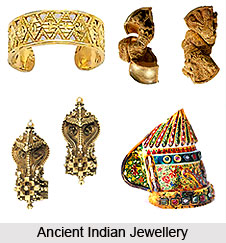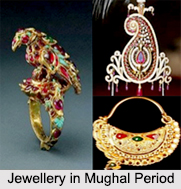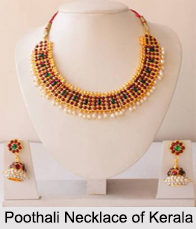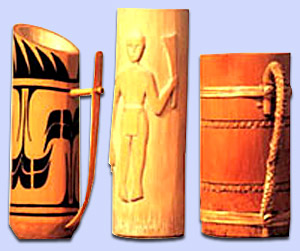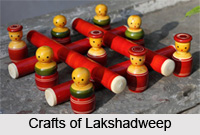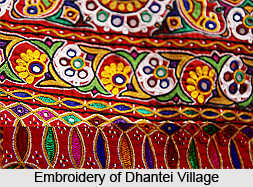Theatre craft is a form of craft that is used in theatres. India is a country that promotes and encourages this type of craft. The states of India like Orissa, Rajasthan, Karnataka etc are predominantly the places where theatre craft had been booming through years.
To start with the theatre craft in the Indian states, Orissa has a history of folk theatre. This is also known as `jatra`(type of puppet show) in local parlance. The characters of these `jatras` are made of wood and are vividly painted. The characters are dressed accordingly and are controlled by strings.
Orissa often hosts play by the nomadic performers based on the epics and other historical characters. Masks are used according to the characters. These masks, a part of the theatre craft, are made of wood that is predominantly light drift wood, sholapith and paper-mache. The artisans, who are mostly from Puri, use bright colours on the masks.
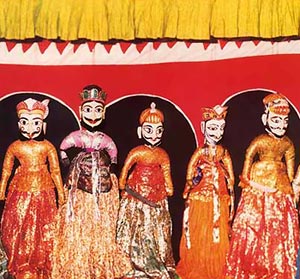 Usage of puppets is another practice of the theatre craft in India. Rajasthan is famous for making puppets. The string puppets of Rajasthan are known as `kathputhlis` in the local lingo and the main centres where they are made are Jaipur and Jodhpur. The puppets are mostly two feet in height and have a wooden head with an enormous nose and large eyes. The rest of the body of the puppets are made of colourful and bright pieces of cloth and stuffed rags as they are used on the stage. The costumes of the puppets are regional and traditional and on the other hand the themes that are performed revolve around Rajasthani historical tales or local legends.
Usage of puppets is another practice of the theatre craft in India. Rajasthan is famous for making puppets. The string puppets of Rajasthan are known as `kathputhlis` in the local lingo and the main centres where they are made are Jaipur and Jodhpur. The puppets are mostly two feet in height and have a wooden head with an enormous nose and large eyes. The rest of the body of the puppets are made of colourful and bright pieces of cloth and stuffed rags as they are used on the stage. The costumes of the puppets are regional and traditional and on the other hand the themes that are performed revolve around Rajasthani historical tales or local legends.
Another form of theatre craft is the leather shadow puppets. The shadow play or puppet show with leather figures is an art form of ancient times. Goat or sheep leather is extensively used in the manufacture of these puppets. The skin is first stretched tight and is nailed at the corners to keep it intact in the shape. The puppet figure is then traced on the leather and cut out with a very fine chisel. The leather puppets are decked with all possible ornaments and clothing which are designed by drilling different kinds of holes in the skin. The leather puppets are painted with colours obtained from vegetable and mineral sources. There are puppets for birds, trees, animals and even the sea counter parts.
Another Indian state where theatre craft flourished is Karnataka. The local and popular folk drama `Yakshaganga` is conducted through string puppetry shows which are famous among the locale of Karnataka. The dolls or the puppets used in this form of Indian art are an outstanding example of Indian theatre craft. Besides these, there are the `Kiritams,` the expressive headgears worn by Kathakali dancers. This particular item is designed for the part played by the dancers. The Indian craftsmen take care of minute details while making such theatre crafts. For instance, the colours, sizes, girdle, designs etc are taken care of. On the other hand, different headgears are made to represent different characters. The headgears of religious figures, strong, gentle, devoted, and loyal differs from the headgears of vicious and destructive characters.
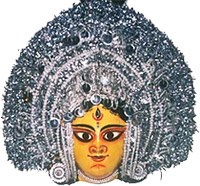 The expansion of theatre craft is also noticed in West Bengal. The wooden masks of West Bengal are an important part of the social and cultural activities of the state. The craftsmen of this state mainly of Purulia make wooden masks for the `chhou` dancers. In Malda, the masks are used by the `Gambhira` dancers. The hilly areas of Darjeeling and Tibet also use masks in their devil dances and other religious festivals. `Chhou` masks are distinguishable as they represent the gods, goddess and characters from the mythology and history of India. Through the progression of ages, the wooden masks have evolved into an admirable theatre craftsmanship with its exquisite design and finish. The artisans for `chhou` masks are mostly located in and around Charida and Bagmundi of Purulia district. The artistry of hilly areas allows the wood carving on wood masks which are painted vividly with exclusive colours representing the evil spirits of the mountains and the demons.
The expansion of theatre craft is also noticed in West Bengal. The wooden masks of West Bengal are an important part of the social and cultural activities of the state. The craftsmen of this state mainly of Purulia make wooden masks for the `chhou` dancers. In Malda, the masks are used by the `Gambhira` dancers. The hilly areas of Darjeeling and Tibet also use masks in their devil dances and other religious festivals. `Chhou` masks are distinguishable as they represent the gods, goddess and characters from the mythology and history of India. Through the progression of ages, the wooden masks have evolved into an admirable theatre craftsmanship with its exquisite design and finish. The artisans for `chhou` masks are mostly located in and around Charida and Bagmundi of Purulia district. The artistry of hilly areas allows the wood carving on wood masks which are painted vividly with exclusive colours representing the evil spirits of the mountains and the demons.
